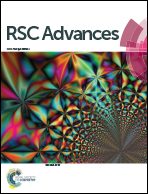Study of Schottky contact in binary and ternary hybrid CdSe quantum dot solar cells
Abstract
Hybrid binary and ternary organic solar cell devices were fabricated from P3HT–PCBM with CdSe quantum dot materials. The binary and ternary structured solar cells were designed with the combinations of P3HT–PCBM (device A), P3HT–CdSe (device B) and P3HT–CdSe–PCBM (device C). The absorption spectra of P3HT, CdSe and PCBM were analyzed in the wavelength range from 350 nm to 800 nm. The current density–voltage characteristics of the devices were performed in the dark and under illumination to study the conduction process and solar cell performance. The ideality factor of all the devices is more than one. The capacitance–voltage analysis of the devices shows that the depletion width of the binary device (WA and B ∼ 39 and 30.8 nm) is lower than the ternary device (Wc ∼ 46.8 nm). The carrier densities of device A, B and C are 1.49 × 1023 m−3, 0.52 × 1023 m−3 and 2.6 × 1023 m−3, respectively. The device can be modeled as the combination of two RC parallel circuits (one for the active layer, and the other for the interface) in series with contact resistance Rs ∼ 0 ohm for device A, B and 60 ohm for device C.


 Please wait while we load your content...
Please wait while we load your content...